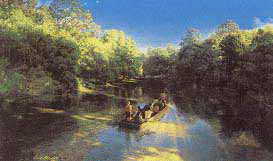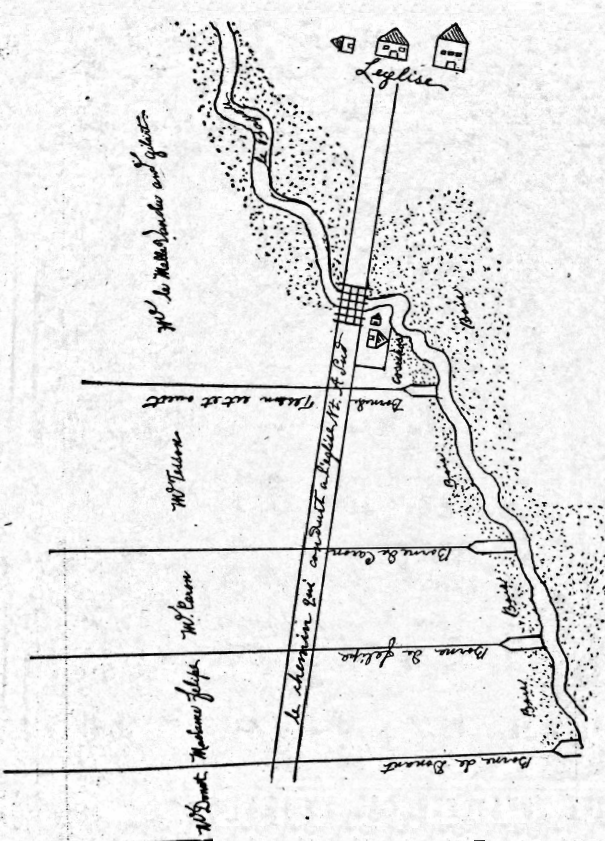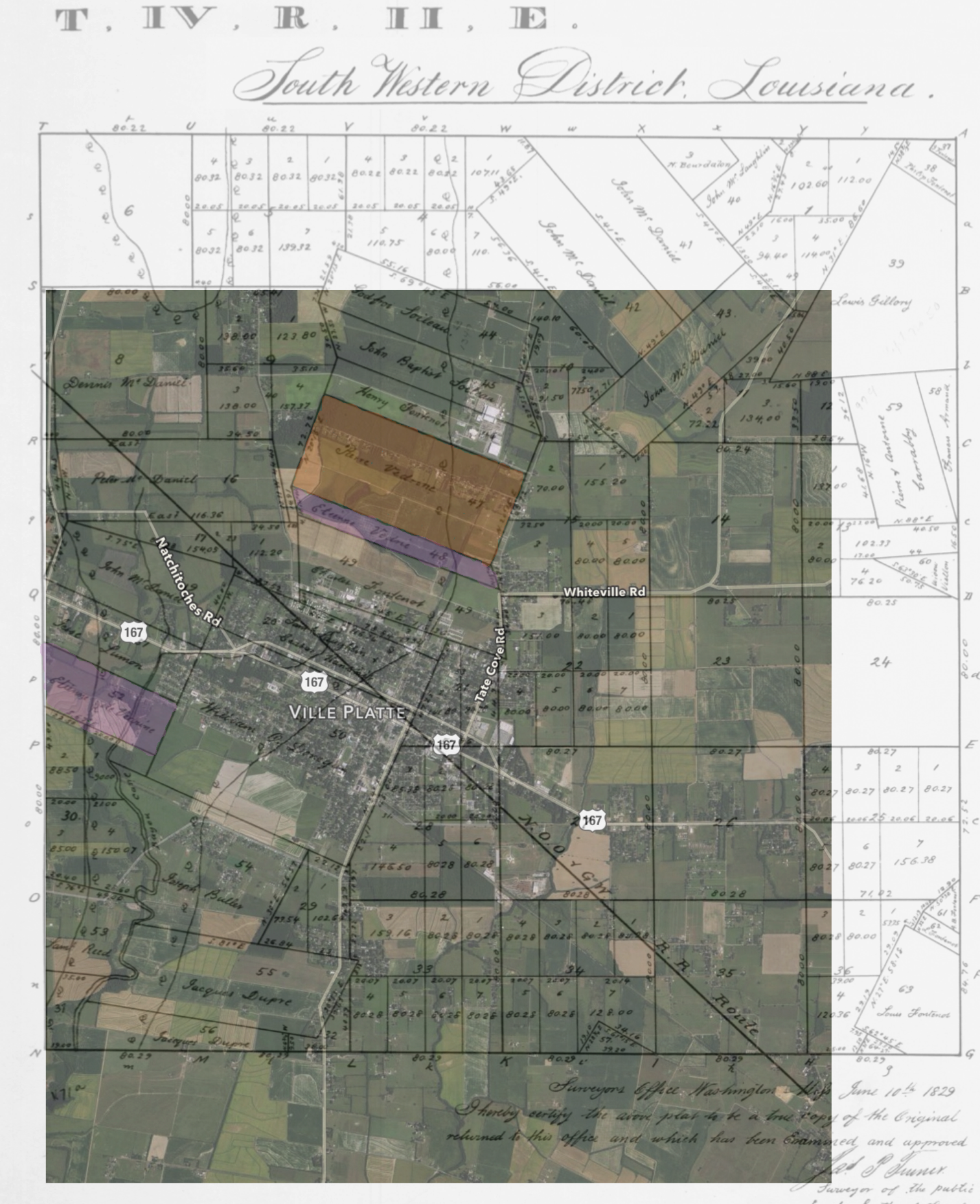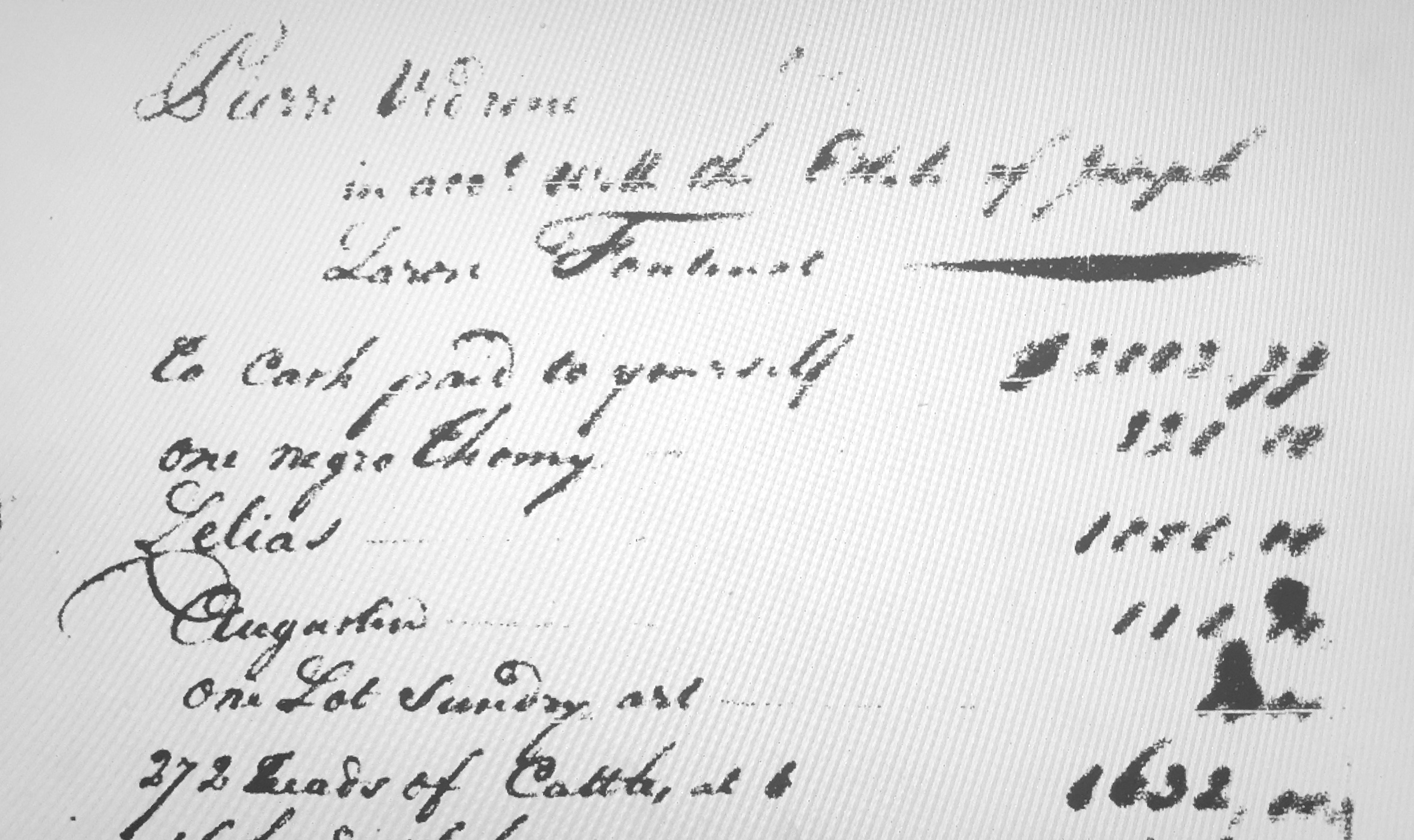275th Anniversary: Jean Baptiste Pierre Vidrine
The Vidrine Family in LA celebrates the 275th anniversary of Jean Baptiste Lapaise de Védrines’ departure from France and arrival of LA in 2018. It’s a great time to remember and reflect on the 275 years of history of his descendants and the life and family he established in LA.
Jean Baptiste Pierre Vidrine (sometimes seen as de Védrines) was the first-born son and second child of Jean Baptiste Lapaise de Védrines and Elisabeth de Moncharvaux. As such, he was truly the first native-born son of the Vidrine Family in the new world. He was born in 1762 at Fort Chartres, IL, one year before his small family would be uprooted from the Pays des Illinois, which was lost to the British in the French and Indian War, and head south for a life more suitable in French, Catholic South LA. When he was born, his father was 50 and his mother was 18 and had been married for about four years.
About one year after the birth of Jean Baptiste Pierre Vidrine, the Treaty of Paris was  signed, bringing an end to the War with the British. His father, having retired from the French Marines, must have begun his descent down the Mississippi River with his family some time after May 10 (Kaskaskia Manuscripts 63:5:10:1) in the summer of 1763. A few months later, they arrived in New Orleans, the city his father had first arrived at from France in 1743, and which he had served for nine years before being sent up to the Illinois Country.
signed, bringing an end to the War with the British. His father, having retired from the French Marines, must have begun his descent down the Mississippi River with his family some time after May 10 (Kaskaskia Manuscripts 63:5:10:1) in the summer of 1763. A few months later, they arrived in New Orleans, the city his father had first arrived at from France in 1743, and which he had served for nine years before being sent up to the Illinois Country.
Jean Baptiste Lapaise along with his wife, Elisabeth and their family probably spent anywhere from a few months to a year in the city of New Orleans as many did at the time (David Lanclos, The letters of Dr. Franc̦ois Robin 1784-1826, 2009, p. 36) before deciding to move about 120 miles up the Mississippi River from New Orleans to the Post of Pointe Coupée. Jean Baptiste Pierre Vidrine spent his years as a young boy in Pointe Coupee as his family lived there for about eight years, from 1765-1773.
In the Spanish Census of Pointe Coupee taken on April 25, 1766, Jean Baptiste Pierre Vidrine, was 4 years old living with his father and mother and his three sisters: Marie Jeanne (age 6), Agnes (age 3), and Perrine (age 1). They had 4 arpents of land and one slave. (LGHS Genealogical Register, Vol VII, No. 3, p. 1, September 1960).
Three years later, in the Spanish Census of Pointe Coupee taken in 1769, Jean Baptiste Pierre (7) is listed among the children of Jean Baptiste Lapaise and Elisabeth de Védrines as the only boy with his three sisters: Marie Jeanne (8), Agnes (6), and Perrine (4) (Le Raconteur, Vol XXXV, No. 2, June 2015).
In May 1773, Jean Baptiste Lapaise de Védrines received a grant of land at the Opelousas Post from the Spanish Government. (Pointe Coupee Documents, 1762-1803: A Calendar of Civil Records for the Province of Louisiana, Winston Deville, p. 100 (Apendix)). So eight years after arriving at Pointe Coupée, he departed, moving his family west to the Opelousas Post…leaving no trace of the Védrines-Vidrine family there (as at New Orleans) except for the information about them in the civil and ecclesiastical records.
 The Spanish Census of the Opelousas Post taken a few months later in May 1777 lists Jean Baptiste Pierre Vidrine as 15 years old in the household of Jean Baptiste Lapaise and Elisabeth de Védrines along with his siblings: Agnes (age 14), Perrine (age 12), and Etienne (age 7). Also listed are 7 cattle, 1 horse, and a negro slave named Cizar (age 32) (Winston Deville, Southwest Louisiana Families in 1777, Ville Platte LA, 1987).
The Spanish Census of the Opelousas Post taken a few months later in May 1777 lists Jean Baptiste Pierre Vidrine as 15 years old in the household of Jean Baptiste Lapaise and Elisabeth de Védrines along with his siblings: Agnes (age 14), Perrine (age 12), and Etienne (age 7). Also listed are 7 cattle, 1 horse, and a negro slave named Cizar (age 32) (Winston Deville, Southwest Louisiana Families in 1777, Ville Platte LA, 1987).
Eight years later, in the 1785 Spanish Census of the Opelousas Post taken by Commandant DeClouet, Jean Baptiste Pierre Vidrine was 23 years old still in the home of his parents. His father was 72 and his mother was 41. His siblings Perrine (20), and Etienne (15) also appear. They had 1 male slave over 50 and 1 female slave over 50 (Winston Deville, Southwest Louisiana Families in 1785, Ville Platte LA, 1991).
About six months after his father’s death in January of 1788, Jean Baptiste Pierre Vidrine (26 years old) was married to Marie-Josephe Brignac (17 years old) on July 7, 1788 at the church of the Opelousas Post (Washington, LA) by their Pastor, Fr. Joseph de Arazena (St. Landry Church, V.1-A, p.16).
Their first-born son, Pierre, Jr. was born a year and a half later, on January 3, 1790 and baptized a month afterward (V.1-A, p.96). Their second son, Lisandre Jean Baptiste was born on August 29, 1791 and baptized a month later (V.1, p.113). They then had two daughters, Marie Celestine, born on April 14, 1793 and Hyacinth born a year later in 1794.
In 1795, Jean Baptiste Pierre is mentioned in the succession of his aunt, Marie Anne de Moncharvaux Robin as the tutor of her daughter, Elisabeth Clermont.
The Spanish Census of the Opelousas Post taken on May 23, 1796, lists Jean Baptiste  Pierre Vidrine living at the Quartier de L’Eglise near his mother. However, he appears to have also homesteaded land to the west in the Prairie known as the Quartier dit Baton Rouge (which would later be named Ville Platte) some time before 1796, while retaining his land at the Opelousas Post (Washington, LA). His brother Etienne Vidrine followed after him, settling on land in September of 1796 next to Jean Baptiste Pierre at the Quartier dit Baton Rouge, which he bought from his father in law, Noel Soileau (American State Papers: Public Lands, Vol III, 1834, p. 158).
Pierre Vidrine living at the Quartier de L’Eglise near his mother. However, he appears to have also homesteaded land to the west in the Prairie known as the Quartier dit Baton Rouge (which would later be named Ville Platte) some time before 1796, while retaining his land at the Opelousas Post (Washington, LA). His brother Etienne Vidrine followed after him, settling on land in September of 1796 next to Jean Baptiste Pierre at the Quartier dit Baton Rouge, which he bought from his father in law, Noel Soileau (American State Papers: Public Lands, Vol III, 1834, p. 158).
As was stated in the previous article about the Quartier dit du Baton Rouge, one legend in LA found in Bruce Ardoin’s book about the Vidrine Family passed down in his family by one of his great uncles, Alfred Ardoin, who knew the Vidrine family very well) claimed that the Vedrines (Vidrine) and his wife who settled at the Quartier dit du Baton Rouge came directly from France. We know that Jean Baptiste Pierre Vidrine was the first to settle there and didn’t arrive directly from France (He was born in IL and raised in LA and his wife, Marie-Josephe Brignac was born at the Pointe Coupee Post). However, the legend does let us know that while he was one of the early settlers at the Quartier dit du Baton Rouge, there were others who settled in the area before he did.
On Christmas day in 1797, Jean Baptiste Pierre and Marie-Joseph’s fifth child and third son, Florentin Pierre, Sr. was born at the Quartier dit du Baton Rouge (Ville Platte, LA). Their fourth son and sixth child, Jean Baptiste dit Doisite was born on March 15, 1799, Their seventh child and third daughter, Marie Denise was born in April 1801. And their fourth son and eighth child, Denis, Sr. was born in February 1803.
On October 19, 1803, a few months after the Louisiana Purchase, Jean Baptiste Pierre Vidrine sold his land at the Opelousas Post to William Reed, a blacksmith, which had 12 arpents in front and was located at the Prairie de deux Marees on the Royal Road from the old church to Grand Prairie which he had acquired from Baptiste Guillory (Land Grants SW, p. 222). He filed a land claim at the Quartier dit du Baton Rouge (Ville Platte) in February of 1806 for the land he had previously homesteaded under the Spanish government. Also in 1803, his brother Etienne sold the property he had purchased next to him and moved to the south west of his former property, filing a land claim in June of 1807.
The fifth son and ninth child of Jean Baptiste Pierre and Marie-Josephe, Joseph was born in May 1805 at the Quartier dit du Baton Rouge (Ville Platte). Their fourth daughter and tenth child, Marie Elizabeth was born in August 1807.
Two years later, on February 19, 1808 Jean Baptiste Pierre Vidrine, Francois Brignac (his brother-in-law), and Pierre Doucet bought a tract of land together from Joseph Sylvester, and then on the same day, sold it to Benjamin Going.
In the US Census taken in 1810, Jean Baptiste Pierre Vidrine (48) appears with his wife, Marie-Josephe (39), along with their children: Pierre, Jr. (20), Lisandre Jean Baptiste (18), Marie Celestine (16), Hyacinth (15), Florentin Pierre, Sr. (12), Jean Baptiste dit Doisite (10), Marie Denise (9), Denis, Sr. (7), Joseph (5), and Marie Elisabeth (3), and one slave.
Two years later, the eleventh child and fifth daughter of Jean Baptiste Pierre and Marie-Josephe, Marie, was born in July 1812.
 That same year, the War of 1812 began. Both Jean Baptiste Pierre and his brother, Etienne dit Lapaise served in the War of 1812 in the 16th Regiment, Thompson’s LA Militia. Some of his sons served along with him. One interesting note is that we’re able to see that his life was, in a sense, put on hold as they took up the call of duty. Jean Baptiste Pierre Vidrine’s daughter, Marie, was born in 1812…but his next child – his son, Andre Vidrine wasn’t born until August 1815 after the War was over.
That same year, the War of 1812 began. Both Jean Baptiste Pierre and his brother, Etienne dit Lapaise served in the War of 1812 in the 16th Regiment, Thompson’s LA Militia. Some of his sons served along with him. One interesting note is that we’re able to see that his life was, in a sense, put on hold as they took up the call of duty. Jean Baptiste Pierre Vidrine’s daughter, Marie, was born in 1812…but his next child – his son, Andre Vidrine wasn’t born until August 1815 after the War was over.
Members of Jean Baptiste Pierre Vidrine’s family who served in the War of 1812 are included in the list of LA soldiers in the War:
Vederine, Pierre Private 16 Reg’t. (Thompson’s), La. Mil.
[Most likely Jean Baptiste Pierre Vidrine (1762-1830), son of Jean Baptiste Lapaise de Védrines and Elisabeth de Moncharvaux]
Vedrine, Dursite Private 16 Reg’t. (Thompson’s), La. Mil.
[Jean Baptiste dit Doisite Vidrine (1799-1845), son of Jean Baptiste Pierre Vidrine and Marie-Josephe Brignac]
Vedrine, Florentine Private 16 Reg’t. (Thompson’s), La. Mil.
[Florentin Pierre Vidrine, Sr. (1797-1871), son of Jean Baptiste Pierre Vidrine and Marie-Josephe Brignac]
Vedrine, Pierre Private 16 Reg’t. (Thompson’s), La. Mil.
[Most likely Pierre Vidrine, Jr. (1790-1837), son of Jean Baptiste Pierre Vidrine and Marie-Josephe Brignac]
During the War of 1812, in 1813, Fr. Michel Bernard Barrière, an émigré Priest who fled the Revolution in France, was put in charge of St. Landry Church in the Opelousas area. As he had done a few years earlier at the Post of Attakapas to the south of the Post of Opelousas, he continued to saddle his horse for his missionary journeys throughout his parish, and these still occasionally presented extreme difficulties. Fr. Barrière gives us an insight into transportation on the Opelousas Prairie in a note he made in the sacramental register of St. Landry Church. While one of his parishioners on the prairie was dying, “he could not receive the Sacraments due to the high water which flooded everywhere because of the abundant rains which we’ve received for over a month and the lack of bridges” (See St. Landry Death Register, V.1, p. 138).
According to the Baptismal records, in which Fr. Barrière is well known to have provided so many details, he went on a missionary excursion during the month of November 1813, celebrating at least eighteen baptisms. He traveled through the “Prairie Mamou,” to James Campbell’s, then to Mrs. Hall’s, then again to Dennis McDaniel’s at the head of “Bayou Chicot”, then to the “Quartier called Baton Rouge” at the house of “Mr. [Jean] Baptiste de Vidrinne” and finally at Pierre Foret’s, in the “Prairie Ronde” ( Historical Sketch of the Parish of Opelousas, LA, Rev. Charles Souvay, C.M., Saint Louis Catholic Historical Review, Volumes 2-3, (St. Louis, MO: 1920), p. 246; See also St. Landry Baptism Register, Volume 2, p18).
many details, he went on a missionary excursion during the month of November 1813, celebrating at least eighteen baptisms. He traveled through the “Prairie Mamou,” to James Campbell’s, then to Mrs. Hall’s, then again to Dennis McDaniel’s at the head of “Bayou Chicot”, then to the “Quartier called Baton Rouge” at the house of “Mr. [Jean] Baptiste de Vidrinne” and finally at Pierre Foret’s, in the “Prairie Ronde” ( Historical Sketch of the Parish of Opelousas, LA, Rev. Charles Souvay, C.M., Saint Louis Catholic Historical Review, Volumes 2-3, (St. Louis, MO: 1920), p. 246; See also St. Landry Baptism Register, Volume 2, p18).
We know for sure that Fr. Barrière was at the home of Jean Baptiste Pierre Vidrine on November 18, 1813. As he notes in the Sacramental Records, it was during a mission “Dans le quartier dit du Baton Rouge chez Mr. Baptiste de Vidrinne” [in the area called Baton Rouge at Mr. Baptiste de Vidrinne] on November 18, 1813 that he baptized Celeste McDonald (daughter of John McDaniel, Sr. and Catherine Corkran), Damasena Ortego (daughter of Jean Francois Ortego and Eugenie Fontenau), and Margarita Ortego (daughter of Joseph Gregoire Ortego and Emelie Fontenau). During this same time, Fr. Barrière encountered the matron of the Vidrine family in Louisiana, Elisabeth de Monchervaux, who was now living with and receiving care during her sickness from her son Jean Baptiste Pierre Vidrine at the Quartier dit du Baton Rouge.
The next day, we find the following land dispute Jean Baptiste Pierre was involved in:
“Louis Cartier claims 280 acres of land, viz. eighteen arpents front by fifty-four chains deep, on Grand Louis bayou, county of Opelousas. The evidence of Pierre Vedrine, taken the 19th November 1813, states that the claimant has taken his fire wood and timber off the land for the use of the adjoining tract on which he resides, and which being deficient in quantity, the claimant considered himself entitled to the land now claimed to make up this deficit; that he has regularly paid taxes for the same, and the land has always been respected by the neighbors as his property” (American State Papers: Public Lands, Vol III, 1834, p. 201).
Two years later, the twelfth and final child of Jean Baptiste Pierre and Marie-Josephe, Andre (seventh son) was born on August 18, 1815.
By the next fall, Jean Baptiste Pierre’s mother, Elisabeth de Moncharvaux passed away at the age of 72. Fr. Barrière notes in the record of her death and burial that she spent “three long years” at the Quartier dit du Baton Rouge “on the outskirts of the Mamou Prairie” [in the care of her son Pierre Vidrine] before dying there on September 6, 1816. She was buried at the cemetery of St. Landry Church in Opelousas (V.1, p.155). Sadly, though, her tomb can no longer be found.
In the 1820 US Census taken on August 7, 1820, Jean Baptiste Pierre Vidrine (58) appears with his wife, Marie-Josephe (49), and their children: Hyacinth (26), Florentin Pierre, Sr. (22), Jean Baptiste dit Doisite (20), Denis, Sr. (17), Joseph (15), Marie Elizabeth (130, Marie (8), and Andre (5).
After they had been married for 41 years, the wife of Jean Baptiste Pierre Vidrine, Marie-Josephe, passed away in 1829 at the Quartier dit du Baton Rouge at the age of 59.
The next year, in the 1830 US Census, Jean Baptiste Pierre Vidrine (68) was living as a widow with his daughter, Marie (18), and his son, Andre (15).
 At this time, the precise date of Jean Baptiste Pierre Vidrine’s death is unknown, although it was some time after 1830. His will shows that he had 272 heads of cattle, and 16 horses, and at least one slave.
At this time, the precise date of Jean Baptiste Pierre Vidrine’s death is unknown, although it was some time after 1830. His will shows that he had 272 heads of cattle, and 16 horses, and at least one slave.
Jean Baptiste Pierre and Etienne Vidrine dit Lapaise – the two sons of Jean Baptiste Lapaise de Védrines and Elisabeth de Mocharvaux – moved the base of the Vidrine Family from the Opelousas Post to the Ville Platte area. While several of the sons of Etienne dit Lapaise and Victoire would move further west to what is today the Vidrine, Mamou, Duralde, and Basile communities as well as back east to Grand Prairie and Opelousas, most of Jean Baptiste Pierre and Marie-Josephe’s children remained in the vicinity of Ville Platte, a little to the west toward Mamou, and a little north of Bayou Chicot around what is today Turkey Creek, LA. All who carry the name Vidrine today descend from either Jean Baptiste Pierre or his brother, Etienne dit Lapaise and one of their many sons.
